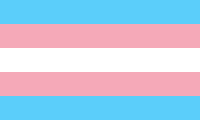
Photo from wikipedia
OBJECTIVE This qualitative research examines how transgender and gender nonbinary (T/GNB) persons from South Carolina navigate informational barriers within healthcare systems. This navigation can be described through the lens of… Click to show full abstract
OBJECTIVE This qualitative research examines how transgender and gender nonbinary (T/GNB) persons from South Carolina navigate informational barriers within healthcare systems. This navigation can be described through the lens of information practices, or how T/GNB participants create, seek, use, and share information to achieve desired healthcare outcomes. Special focus is given to the roles of Information and Communication Technologies (ICTs) in shaping these practices. MATERIALS AND METHODS The research utilizes participant data from semistructured interviews and focus groups conducted with 26 T/GNB individuals focusing on their health information practices. Data analysis utilized emic/etic coding and the constant comparative method to identify themes describing transexclusionary information barriers and respondent ICT-led information practices. RESULTS Findings note healthcare systems producing cisnormativity by design resulting in T/GNB individuals viewing healthcare spaces as exclusionary. Exclusionary barriers included over reliance on medical, expert authority ignoring T/GNB embodiment, and a lack of contextual perspective to identities. In response, T/GNB seek, create, use, and share information via ICTs to challenge exclusionary practices. DISCUSSION T/GNB ICT use addresses systemic barriers within healthcare systems suggesting a need to reframe healthcare systems through the lens of design justice, one that values T/GNB agency in understanding and producing health knowledge. CONCLUSION While many healthcare providers are not intentionally being transexclusionary, the design of healthcare information systems rely on cisnormative values, thus excluding many T/GNB from accessing healthcare in comfortable and safe ways. Shifting toward the values and practices of T/GNB as informed by ICT use will afford healthcare providers ways to undo barriers to care.
Journal Title: Journal of the American Medical Informatics Association : JAMIA
Year Published: 2021
Link to full text (if available)
Share on Social Media: Sign Up to like & get
recommendations!